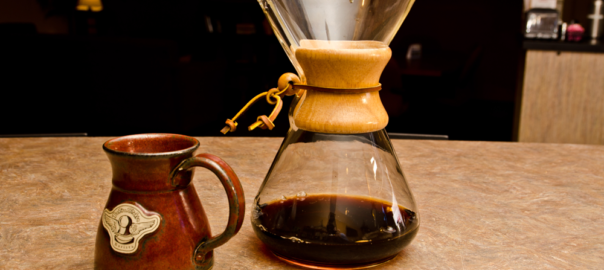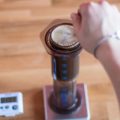 Peter Schlumbohm was a larger-than-life inventor, marketer, and idea-man. At over 6 ft tall and around 300lbs, he was a hard man to miss. He loved food, women, and coming up with new ways of streamlining and solving old problems.
Peter Schlumbohm was a larger-than-life inventor, marketer, and idea-man. At over 6 ft tall and around 300lbs, he was a hard man to miss. He loved food, women, and coming up with new ways of streamlining and solving old problems.
Schlumbohm filed a patent for a brand-new coffee brewing device on April 13, 1939. By 1944 it was featured in the Museum of Modern Art as one of the best designed products. It’s simple, yet elegant – utilitarian, yet beautiful. It’s called The Chemex, and as its inventor put it, “with the Chemex, even a moron can make good coffee.”
The Coffee Guy
Episode Transcript:
It’s hard to remember a time when war wasn’t controversial. Being against conflict is easy for us today – for the most part human rights violations and bombings don’t impact our everyday lives. War is expensive in more ways than one, and unwieldy. Historically speaking, being on the right side of war is most strongly correlated with whether or not your side won. Winston Churchill famously said, “history is written by the victors.”
In 1937 the United States was condemning the war in Europe while maintaining formal neutrality. The U.S. was supplying Britain, the Soviet Union, and China with war materials, but was largely staying out of the ground, sea, and air conflicts. President Franklin D. Roosevelt was adamant on this point, while still using harsh rhetoric to condemn the actions of Nazi Germany. On October 5, 1937, President Roosevelt gave a famous speech, now called the “Quarantine Speech.”
-FDR Quarantine Speech-
Following the attacks on Pearl Harbor in December, 1941, the discussion changed, and so did the tide of the war.
-FDR War Speech-
The principles of peace that the U.S. adopted following WWI were now being bent to end tyranny abroad.
World War II gives us a massive look into the American psyche, and in many ways shaped the DNA of the nation. Nobody was exempt from the war. There was no ignoring it, and everybody was expected to contribute. High tax rates were put into effect, and the income levels associated with those rates were lowered. For example, the income levels associated with the highest tax brackets were lowered from $5 million/year to $200,000/year.
The ways the war impacted everyday Americans didn’t stop at taxes, however. In 1942 a rationing system was implemented to limit the consumption and use of necessities needed for the war effort, while at the same time guaranteeing a minimum amount for everyone, especially poor people.
Tires were rationed first – supplies of natural rubber had been interrupted – followed by gasoline. By 1943 rationing had extended to basic household items like sugar, meat, cheese, butter, clothing, bicycles, shoes, and yes – coffee. American citizens were given government-issued ration coupons to purchase specified amounts of all of these items, and more.
While extremely uncomfortable and irritating for average Americans, this rationing system did get a lot of public support. Everybody knew that supporting the soldiers and sailors overseas wasn’t an option or preference, it was a necessity. Winning the war was important to everyone, and so people gave.
The private sector quickly picked up on this American sentiment, and everything from design to sales mirrored this shift in public opinion. Frivolous design was replaced with simple, utilitarian composition, and products were being made using materials considered less important to the war effort. You can practically hear a 1940s salesman convincing an American prospective buyer that by purchasing this simply made, conventional product you’re “helping our boys kill Nazis.”
It’s no secret that World War II-era Americans loved coffee. Some statistics indicate that in the 1940s and 50s, twice as many Americans drank coffee than they do today, and on average they would drink 2-3 more cups per day – maybe coffee rationing wasn’t such a bad idea.
Out of this new public perception, war-effort salesmanship, and love for coffee arose a beautiful alternative to conventional brewing. A german inventor and immigrant to America named Peter Schlumbohm filed a patent for this new brewing device on April 13, 1939. By 1944 it was featured in the Museum of Modern Art as one of the best designed products. It’s simple, yet elegant – utilitarian, yet beautiful. It’s called The Chemex, and as its inventor put it, “with the Chemex, even a moron can make good coffee.”
I’m Colin Mansfield, and this is The Boise Coffee Podcast.
Peter Schlumbohm was a larger-than-life inventor, marketer, and idea-man. At over 6 ft tall and around 300lbs, he was a hard man to miss. He loved food, women, and coming up with new ways of streamlining and solving old problems. At one point he invented an original all-in-one-machine: it was an electric oven, ice-cream maker, frozen food chest, thermos, dishwasher, and air conditioner called the Tempot. He managed to get Time magazine to report on this crazy invention in 1946, though later they found out he had only ever made 20 of them. Like most inventors, Schlumbohm had a roller-coaster life before creating his famed coffee brewer.
Schlumbohm was born in 1896 in Kiel, Germany. Shortly after graduating from the German equivalent of high school, he was conscripted into the German Army to fight in World War I. After returning to Germany in 1918, Schlumbohm began his academic pursuits, convincing his family to pay for his school in return for giving up his father’s eventual inheritance. At around this time he expressed anti-war sentiments, going so far as to call for the abolition of the military.
Schlumbohm attended the University of Berlin and spent eight years pursuing a doctorate in Chemistry, which he achieved. In the years following graduation, Schlumbohm kept himself financially afloat by selling patents and working on various scientific and personal projects.
In 1931 Dr. Schlumbohm visited the United States in hopes of selling patent rights related to the manufacture of dry ice. This experience proved to be surprisingly lucrative for the German chemist, and while he hated the corporate mindset of American businesses, patent regulations in the United States proved too good for him to pass up.
Between 1931 and 1939 Schlumbohm filed dozens of patents, many of which were centered around refrigeration – something he considered particularly important for the modern era. His other patent filings included applications for unburnable gasoline, a method of illuminating rooms, and a writing utensil. The loud, boisterous man was digging into every nook and cranny of his expertise to find the golden egg that would give him the financial independence he had been seeking since achieving his doctorate.
Finally, in 1939, Schlumbohm had his first apparent break. After showcasing his latest attempt to perfect refrigeration at the New York World’s Fair – a device he had been working on for several years – Schlumbohm was approached by a prospective investor. The offer was straightforward: the investor would provide enough money to make the prototype device a reality in exchange for a controlling interest in the company.
Agreeing to these terms would not only mean an opportunity to finally get a device he invented on the market, it would also mean up-front cash.
His decision, after the break.
-Advertisement-
Today’s episode of The Boise Coffee Podcast is brought to you by Audible. With over 180,000 audiobooks to choose from, Audible is the best way to find a title you’ll love and listen to it wherever you are. I recently picked up “Grit: The Power of Passion and Perseverance” by Angela Duckworth. It’s a look into the real reason why some people stick through challenges and thrive, while others give up. Based on her psychology research, Duckworth says that the secret to outstanding achievement is not talent, but instead a special blend of passion and persistence that she calls “grit.” If you enjoy books from Malcolm Gladwell or titles similar to Freakenomics, you’ll love this book.
Audible is giving listeners of The Boise Coffee Podcast a free 30-day trial, as well as a free audiobook of your choice if you sign up today. Visit audibletrial.com/BoiseCoffee to get your free book and support my podcast. That’s a-u-d-i-b-l-e-trial.com/boisecoffee.
-End Advertisement-
Schlumbohm said no. He simply couldn’t stomach giving away any percentage of his company as a cash grab. He said, “To afford that refusal, I had to take an appraising look at the other arrows in my quiver. There was this new patent for the coffeemaker, with its broad appeal. Within a week, I had sold half-an-interest in it for $5000 and planned to license it.” Turning the last several years of his work in refrigeration on its head, Schlumbohm rushed headlong into the world of coffee.
On April 13, 1939 patent no. 2,241,368 for a “Filtering Device” had been filed. The original version of the Chemex included a spout and handle and was intended for uses both in a laboratory and at home.
Later that year, Schlumbohm, an acquaintance named Isaac Harter, and a man named Edward Turner incorporated The Chemex Corporation in New York State. As per state regulations, two-thirds of a company’s directorate had to be American citizens – Edward Turner was brought in to fulfill that requirement, and was given a minority holding of one share for his troubles.
In that same year, Schlumbohm was perfecting an updated design for the product – the same design that would end up in the Museum of Modern Art just 5 years later.
The Chemex is essentially a big glass beaker, somewhat in the shape of an hourglass. It features a molded groove on one side, allowing for easy pouring, as well as a glass level button towards the bottom. The middle of the Chemex is sheathed in a wood corset tied together with a rawhide strip and round wood bead. When assembled, the wooden sheath provides protection from the hot glass, making the Chemex easy to hold and pour from. As for the filter – Chemex recommends you use their circular paper filters, folded to form a simple cone shape.
The Chemex originally sold for around $6, and was produced by Corning Glass Works in NY after Schlumbohm received approval from the War Production Board in the U.S. – remember, this was during the World War II rations period.
While other similar products used in-demand materials like aluminum and chrome, this all-glass coffee maker was both functionally relevant and designedly desirable to U.S. citizens. The Chemex is strongly tied to the Bauhaus style, also called the International Style, an approach to design that argues there should be no distinction between form and function. It’s marked by the absence of ornamentation and the marriage between the function of an object and its design. The Bauhaus style was dominant in the US in the 40s, largely because of the war effort.
Schlumbohm capitalized on the success of his new coffee maker well into the 1950s, placing cartoon advertisements in every magazine he could, and showing it off at trade shows and international expositions. Schlumbohm used other non-conventional methods of advertising as well; he believed in the soft sell, giving the Chemex as a gift to famous cartoonist Charles Addams, President Harry Truman, and President Lyndon B. Johnson. And…it worked. If you look closely, you can find Chemex coffee makers in media, television, and books to this day. It appeared in The Mary Tyler Moore Show, the pilot of 90s sitcom Friends, Don Draper’s kitchen in Mad Men, and is even in Ian Fleming’s James Bond novel “From Russia With Love.” Apparently, Mr. Bond makes his coffee the American way.
Peter Schlumbohm spent his later years as a carefree bachelor with an erratic work schedule. His daily agenda in the 50s consisted of sleeping well into the afternoon, coming into his New York City studio to work at around 5pm, then leaving for dinner after only an hour or two. But “dinner” was usually an all-night affair, consisting of Schlumbohm taking to New York City in his Cadillac Coupe De Ville (complete with gold Chemex hood ornament), often with friends. They’d stop at one of the inventor’s favorite restaurants, eat a course, then pile back into the car to move on to the next joint. Schlumbohms friend, cartoonist Roy Doty, remarked on these common all-night jaunts saying “Eventually you’d be somewhere eating streusel with him and by that time it was two or three in the morning.” This was when Schlumbohm, according to himself, did his best work. Surrounded by other night-owls, he would begin discussing new ideas and making calls well into the morning. Eventually he would return to his Greenwich Village penthouse to enjoy a German beer or some wine before bed.
Peter Schlumbohm died of a heart attack in 1962. He held the rights to over 300 inventions, which he had continued to make and sell even after the success of the Chemex. In a eulogy for Schlumbohm shortly after his death, the notable design author Ralph Caplan described the typical Schlumbohm invention as “a synthesis of logic and madness.”
Today, the Chemex is used in specialty coffee shops, cafes, and homes all around the world. There are multiple sizes of the famous coffee maker, along with a glass-handled variant that is absent the wood corset. As for price, it runs from $40-$50 depending on the style and purchasing location.
The Chemex, for some reason, has an incredible staying power in culture. While the rise of specialty coffee in recent years has brought about a new wave of appreciation for simple brewing techniques, the Chemex seems timeless. The coffee that the Chemex produces is void of all fine coffee grounds that might muddy the taste, producing a cup that has distinctly clear flavor profiles, and consistently great quality. Some people argue that its the design of the Chemex – the angle of the cone, or maybe its smooth glass. Others say its the filters – the folded, circular paper filters are unique to the Chemex, even to today. I tend to believe that, like its design, there is no one factor that sets the Chemex apart from other manual drip cones. Instead, its the synthesis of everything: that marriage of design and utility, the logic and madness of the inventor; all of it coming together in a focused way to do one thing well: make great coffee.
Thanks for listening to The Boise Coffee Podcast. As always, I’m your host Colin Mansfield. I really appreciate your support and the great dialogue I’ve had with some of you recently. If you’d like to get in touch with me, you can find me on twitter, my handle is @BoiseCoffee, or my blog, BoiseCoffee.org. If you like what you heard today, check out my other episodes on iTunes, Stitcher or SoundCloud and leave me a review. Today’s episode was sponsored by Audible. To claim your free audiobook and get a 30-day free trial, visit audibletrial.com/BoiseCoffee. Thanks for listening, and have an awesome rest of your week.
Sources used for this episode:
- “Mr. Chemex: The Eccentric Inventor Who Reimagined the Perfect Cup of Coffee,” Collectors Weekly
- “DR. CHEMEX,” Gourmet
- “Marc Harrison Papers,” Hagley Museum and Library
- “Chemex Brewing: Paper vs Metal Filters,” Clive Coffee
- “Peter Schlumbohm,” Wikipedia
Podcast: Play in new window | Download
Subscribe: Apple Podcasts | Android | Stitcher | RSS



